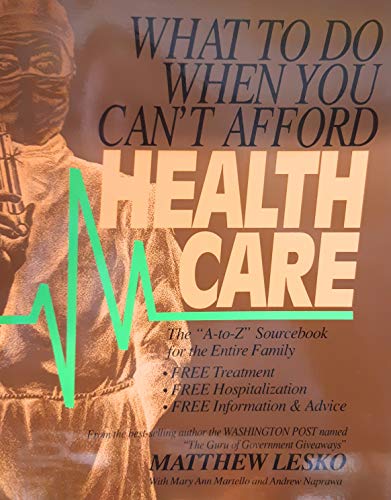With this latest publication, Lesko directs his public-awareness crusade for getting something for nothing toward the health-care field.
What to Do When You Can't Afford Health Care is filled with resources to consult for obtaining free medical advice, services, and treatment. Once again, the author is convinced that if one knows the right experts and organizations to turn to for help, one can get almost anything for free. Case studies, included as examples in the introduction, serve to illustrate just how the system can work for you. Lesko's basic telephone tips are an essential part of the door-opening process. Knowing how to ask is equally as important as knowing who to ask.
The format of this guide differs little from the author's previous books. In fact, if one looks hard enough, much of the contact information can be found in his other publications. The beauty of this book is that everything pertaining to this field has been brought together into one convenient and accessible resource. There are local and national listings for public-health hotlines, medical associations, pharmaceutical contacts willing to fill prescriptions without charge, and sources of assistance for the disabled. An alphabetical listing of medical diseases and conditions comprises the bulk of the text. Each entry contains at least one source of reference--either a clearinghouse, telephone hotline, or publication; most entries list all these sources plus videos on the subject. The more widely known and more widely researched ailments, such as heart disease, AIDS, cancers, and sudden infant death syndrome, have multiple contacts and extensive publication and video listings. It is interesting to note that such topics as exercise, fast food, family violence, radon, nursing homes, and nutrition are included in this section on medical conditions. Information regarding free legal assistance follows in a separate section. The type of complaints covered here are aging services, cosmetics, doctors, occupational safety, medical fraud, nursing homes, and product-safety devices. Listings of ongoing clinical studies and their contacts are found in the appendix.
All in all, this is a handy guide intended for general use. Most libraries will want to keep at least one copy on the reference shelf and have additional circulating copies. Readers must be cautioned, however, about the currency of information. As the author indicates, addresses and telephone numbers are subject to change, and as they do, the book will become outdated.
"Why pay for medical treatment... when the Government is paying the best doctors in the world to treat you for free?" Having gotten your attention with this question, free information expert Lesko guides you through the complex maze of medical resources. As in his previous books ( Information USA , LJ 9/1/83, and The Great American Gripe Book , LJ 5/15/91), Lesko has collected and organized a directory of resources to assist patients, care givers, and students. Included are information hotlines, consumer agencies, regulatory bureaus, legal assistance, and an alphabetical list of diseases (and associated organizations), from the common cold to the so-called "orphans"--diseases so rare that drug companies and hospitals often don't offer treatment, even when available, because it it not cost-effective. A vital reference source for public libraries. Highly recommended.
- Susan B. Hagloch, Tus carawas Cty. P.L., New Philadelphia, OhioCopyright 1993 Reed Business Information, Inc.
